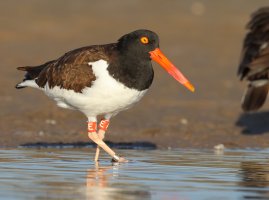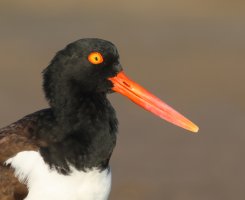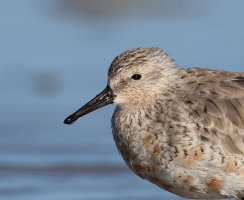Brent Hall and other birders have reported as low as 20% keeper rates with the EOS R7 due to poor tracking autofocus wih the EOS R7. Sad news for me, because the camera seems to shine in most other respects, with wonderful lines per mm resolution in an APS-C sensor. Really hope they fix this!
You are using an out of date browser. It may not display this or other websites correctly.
You should upgrade or use an alternative browser.
You should upgrade or use an alternative browser.
EOS R7 - will there be an update that corrects autofocus issues?
- Thread starter runbei
- Start date
I bought a R7 and have used it for about three weeks. So far I've not had any problems with the auto focus. Just like the R5, it sometimes doesn't see a small bird against a busy background or behind twigs and leaves, but depending on the situation, that can be solved by setting the AF-On button to Spot AF or Single Point AF. Canon does mention the small bird situation in the manual.
The tracking easily grabs birds in flight and sticks to them. When I look at them later on my computer, they are in focus.
I'm certainly no pro but my keeper rate is pretty darn good considering my skills aren't pro-level. I've adapted my EF 100-400 II and it works like a charm.
As far as I'm concerned, there is absolutely nothing wrong with the AF of my R7.
Respectfully, maybe you should try one for yourself.
The tracking easily grabs birds in flight and sticks to them. When I look at them later on my computer, they are in focus.
I'm certainly no pro but my keeper rate is pretty darn good considering my skills aren't pro-level. I've adapted my EF 100-400 II and it works like a charm.
As far as I'm concerned, there is absolutely nothing wrong with the AF of my R7.
Respectfully, maybe you should try one for yourself.
Upvote
0
A wonderfully helpful response, thank you very much. Re-reading the comments on Brent Hall's channel, I see that they are all about the 800/11 and 100-500.
I imagine, though I don't know, that long lenses on APS-C with the 1.6x crop factor would make the AF and IBIS systems work hard and might be subject to more errors. But that isn't something I would need to worry about, as I probably wouldn't use anything longer than 135mm if I got the R7.
At this point I'm reluctant to part with the R6, and budget doesn't allow for owning both. But, boy, that R7 sensor sounds intriguing with its extremely high pixel density, and although I've seen only one portrait that I believe puts its glories on display, it is a winner: Frau D. | Pascal Volk | Flickr.
Gratefully,
George
I imagine, though I don't know, that long lenses on APS-C with the 1.6x crop factor would make the AF and IBIS systems work hard and might be subject to more errors. But that isn't something I would need to worry about, as I probably wouldn't use anything longer than 135mm if I got the R7.
At this point I'm reluctant to part with the R6, and budget doesn't allow for owning both. But, boy, that R7 sensor sounds intriguing with its extremely high pixel density, and although I've seen only one portrait that I believe puts its glories on display, it is a winner: Frau D. | Pascal Volk | Flickr.
Gratefully,
George
Upvote
0
Thanks for your response.
Considering what one gets for 1500 US, the R7 is an impressive camera. It is well worth the money.
I have no plans to purchase RF glass. I'm going to continue using my EF lenses. They work fine and are really all I need.
I had never heard of Brent Hall before your post. I don't know if he is photo guy who does camera reviews or a tech guy
who does camera reviews. I'll look at his channel to see.
Have a good night,
Macoose
Considering what one gets for 1500 US, the R7 is an impressive camera. It is well worth the money.
I have no plans to purchase RF glass. I'm going to continue using my EF lenses. They work fine and are really all I need.
I had never heard of Brent Hall before your post. I don't know if he is photo guy who does camera reviews or a tech guy
who does camera reviews. I'll look at his channel to see.
Have a good night,
Macoose
Upvote
0
It is extremely difficult using an 800mm on APS-C for BIF as the field of view is so narrow that you have to be very skilful to keep the bird in frame. For the RF 800mm f/11 it is doubly bad because the AF area is limited to the central area of the sensor by design and so the field of view is narrowed further to being something like that of a 1600mm lens. I am an experienced bird in flight photographer and would only use my 800mm f/11 on my R7 for distant slow flying large birds that drift across the sky. I wouldn’t waste my time watching a Youtube of someone going on about the 800/11 on the R7. A 135mm on the R7 is not going to have any problems.A wonderfully helpful response, thank you very much. Re-reading the comments on Brent Hall's channel, I see that they are all about the 800/11 and 100-500.
I imagine, though I don't know, that long lenses on APS-C with the 1.6x crop factor would make the AF and IBIS systems work hard and might be subject to more errors. But that isn't something I would need to worry about, as I probably wouldn't use anything longer than 135mm if I got the R7.
At this point I'm reluctant to part with the R6, and budget doesn't allow for owning both. But, boy, that R7 sensor sounds intriguing with its extremely high pixel density, and although I've seen only one portrait that I believe puts its glories on display, it is a winner: Frau D. | Pascal Volk | Flickr.
Gratefully,
George
Last edited:
Upvote
0
I know it's been a few weeks since the last reply on this topic, but I recently had the opportunity to test the RF 800mm f/11 on my R6, and I have to say that's not the smartest lens around...
Not only the autofocus area is pretty small (for a mirrorless camera), but also the lens is not very fast at focusing (hello STM...), and I found that it wasn't the quickest at finding eyes in the frame.
It's obviously a budget lens, with a performance probably similar to a kit lens.
But I thought it was very decently sharp, for an 800mm.
I seriously doubt that the RF 100-500mm is a bad performer, though.
Keep in mind that autofocus performance will also depend on the sensor readout speed, since these are mirrorless cameras, and the R6 is quicker than the R7 on that regard. The R7 has an updated version of the sensor that was in the M6 Mark II/90D, so in some aspects it may be a little dated.
Not only the autofocus area is pretty small (for a mirrorless camera), but also the lens is not very fast at focusing (hello STM...), and I found that it wasn't the quickest at finding eyes in the frame.
It's obviously a budget lens, with a performance probably similar to a kit lens.
But I thought it was very decently sharp, for an 800mm.
I seriously doubt that the RF 100-500mm is a bad performer, though.
Keep in mind that autofocus performance will also depend on the sensor readout speed, since these are mirrorless cameras, and the R6 is quicker than the R7 on that regard. The R7 has an updated version of the sensor that was in the M6 Mark II/90D, so in some aspects it may be a little dated.
Upvote
0
I also have very, very low keeper rates with the R7, usually paired with a Canon 500 F4 II lens with and without 1.4 III teleconverter. I used the same lens combo with a 7D Mark II, 80 D, and R6 with them performing perfectly. My usual type of photography is birds, up close, mostly shorebirds. The R7 will often only get a few out of a hundred shots critically sharp. The rest will be slightly off/blurry. The shots i'm talking about are taken in perfect morning light, just beyond min focus distance and even when the bird is stationary. The odd thing is with the first original firmware, I had found a workaround, leaving subject tracking off with eye detect on, it found and focused on the eyes with critically sharp shots 97% of the time. All later firmware updates since the first, eliminated that option. CalC
Upvote
0
You are doing birds in flight at just beyond the minimum focus distance of the EF 500mm II? Its mfd is only 3.6m or 12'. I take off my hat to you at that level of skill! At my more modest skill levels at longer distances, I have to say the R7 is not nearly as good as the R5 for AF for fast BIF. It's also not as as consistent as the R5 for static birds but the keeper rate is still good.I also have very, very low keeper rates with the R7, usually paired with a Canon 500 F4 II lens with and without 1.4 III teleconverter. I used the same lens combo with a 7D Mark II, 80 D, and R6 with them performing perfectly. My usual type of photography is birds, up close, mostly shorebirds. The R7 will often only get a few out of a hundred shots critically sharp. The rest will be slightly off/blurry. The shots i'm talking about are taken in perfect morning light, just beyond min focus distance and even when the bird is stationary. The odd thing is with the first original firmware, I had found a workaround, leaving subject tracking off with eye detect on, it found and focused on the eyes with critically sharp shots 97% of the time. All later firmware updates since the first, eliminated that option. CalC
Upvote
0
Not sure what you mean. You can still have subject tracking OFF and eye detect Enabled. If you went from 97% sharp to very low percentage. perhaps it is time to contact Canon support and send in the camera for repair.I also have very, very low keeper rates with the R7, usually paired with a Canon 500 F4 II lens with and without 1.4 III teleconverter. I used the same lens combo with a 7D Mark II, 80 D, and R6 with them performing perfectly. My usual type of photography is birds, up close, mostly shorebirds. The R7 will often only get a few out of a hundred shots critically sharp. The rest will be slightly off/blurry. The shots i'm talking about are taken in perfect morning light, just beyond min focus distance and even when the bird is stationary. The odd thing is with the first original firmware, I had found a workaround, leaving subject tracking off with eye detect on, it found and focused on the eyes with critically sharp shots 97% of the time. All later firmware updates since the first, eliminated that option. CalC
Upvote
0
Where did you get that I was talking about birds in flight? I specifically stated stationary birds. I've had this problem with Oystercatchers, Red Knots, Piping Plovers, Marbled Godwits etc.. when they are perfectly stationary, almost filling the frame, normally easy shots. I'm using monopod or ground skimmer pod, so it's not me moving. If I have eye detect off and use spot focus focus works as expected but R7 focus squares are bigger than dslr equivalent, harder to get just the eye, R7 spot focus seems slow to focus.You are doing birds in flight at just beyond the minimum focus distance of the EF 500mm II? Its mfd is only 3.6m or 12'. I take off my hat to you at that level of skill! At my more modest skill levels at longer distances, I have to say the R7 is not nearly as good as the R5 for AF for fast BIF. It's also not as as consistent as the R5 for static birds but the keeper rate is still good.
Not sure what you mean. You can still have subject tracking OFF and eye detect Enabled. If you went from 97% sharp to very low percentage. perhaps it is time to contact Canon support and send in the camera for repair.
On the first firmware I could turn subject tracking off and have eye detect on. Every firmware after that, when I turn eye detect on it automatically turns subject tracking on. I called canon support and they stated how I was shooting with subject tracking off and eye detect on was impossible. I will keep calling them.Not sure what you mean. You can still have subject tracking OFF and eye detect Enabled. If you went from 97% sharp to very low percentage. perhaps it is time to contact Canon support and send in the camera for repair.
Upvote
0
Maybe there are different uses of "when" in different regions, You wrote:Where did you get that I was talking about birds in flight? I specifically stated stationary birds. I've had this problem with Oystercatchers, Red Knots, Piping Plovers, Marbled Godwits etc.. when they are perfectly stationary, almost filling the frame, normally easy shots. I'm using monopod or ground skimmer pod, so it's not me moving. If I have eye detect off and use spot focus focus works as expected but R7 focus squares are bigger than dslr equivalent, harder to get just the eye, R7 spot focus seems slow to focus.
"even when" to me means that you were doing both moving and stationary shots and even the stationary ones were not sharp. I would use "even though" to say I was shooting only stationary one. But, perhaps, that is just British English.The shots i'm talking about are taken in perfect morning light, just beyond min focus distance and even when the bird is stationary.
What worries me is the effects of depth of field when shooting large birds at just over the minimum distance. An oystercatcher, for example, is about 45cm (18") long and quite wide. The dof for a 500mm f/4 on R7 at just over the mfd, say at about 5m (16') is only 1cm (0.4") in front or behind, or 3cm (1.2") at twice that distance. You would really need to stop down a lot to get more than a section of the bird in focus.
Actually, to have a bird of 45cm long just fill the frame sideways on of an APS-C with a 500mm lens, it would have to be 10m away. I, personally, would find nearly filling the frame too close and would zoom out or walk backwards and have it fill half or less for a variety reasons, including easier focus and have greater depth of field or importantly to compose the shot with the bird occupying just an appropriate part of the scene - but that is your choice.
Upvote
0
The bird being close or far is not the problem, the problem is vast amounts of pics not in focus. I have tried to attach a pic of one of the Oystercatchers that came out right, like I said up close, stationary, braced w monopod, easy shot but for every one or two correctly focused shots there were 50 or so slightly blurry shots. If this can be figured out, many R7 users will benefit, as many share the same issues as I have.Maybe there are different uses of "when" in different regions, You wrote:
"even when" to me means that you were doing both moving and stationary shots and even the stationary ones were not sharp. I would use "even though" to say I was shooting only stationary one. But, perhaps, that is just British English.
What worries me is the effects of depth of field when shooting large birds at just over the minimum distance. An oystercatcher, for example, is about 45cm (18") long and quite wide. The dof for a 500mm f/4 on R7 at just over the mfd, say at about 5m (16') is only 1cm (0.4") in front or behind, or 3cm (1.2") at twice that distance. You would really need to stop down a lot to get more than a section of the bird in focus.
Actually, to have a bird of 45cm long just fill the frame sideways on of an APS-C with a 500mm lens, it would have to be 10m away. I, personally, would find nearly filling the frame too close and would zoom out or walk backwards and have it fill half or less for a variety reasons, including easier focus and have greater depth of field or importantly to compose the shot with the bird occupying just an appropriate part of the scene - but that is your choice.
Upvote
0
What shutter speeds and modes are you using? There are reports of shutter shock from the preceding shot using EFCS affecting the next in continuous shooting. I use ES for static shots and much else when rolling shutter isn't an issue.The bird being close or far is not the problem, the problem is vast amounts of pics not in focus. I have tried to attach a pic of one of the Oystercatchers that came out right, like I said up close, stationary, braced w monopod, easy shot but for every one or two correctly focused shots there were 50 or so slightly blurry shots. If this can be figured out, many R7 users will benefit, as many share the same issues as I have.
Shutter shock on the R7
There is discussion in various forums about shutter shock with Electronic First Curtain Shutter (EFCS) with the R7. I have been following this and have done careful tests of my own with charts and would like to sum up the situation. Shutter shock can occur when any shutter is opened mechanically...
Last edited:
Upvote
0
Maybe there are different uses of "when" in different regions, You wrote:
"even when" to me means that you were doing both moving and stationary shots and even the stationary ones were not sharp. I would use "even though" to say I was shooting only stationary one. But, perhaps, that is just British English.
What worries me is the effects of depth of field when shooting large birds at just over the minimum distance. An oystercatcher, for example, is about 45cm (18") long and quite wide. The dof for a 500mm f/4 on R7 at just over the mfd, say at about 5m (16') is only 1cm (0.4") in front or behind, or 3cm (1.2") at twice that distance. You would really need to stop down a lot to get more than a section of the bird in focus.
Actually, to have a bird of 45cm long just fill the frame sideways on of an APS-C with a 500mm lens, it would have to be 10m away. I, personally, would find nearly filling the frame too close and would zoom out or walk backwards and have it fill half or less for a variety reasons, including easier focus and have greater depth of field or importantly to compose the shot with the bird occupying just an appropriate part of the scene - but that is your choice.
Maybe there are different uses of "when" in different regions, You wrote:
"even when" to me means that you were doing both moving and stationary shots and even the stationary ones were not sharp. I would use "even though" to say I was shooting only stationary one. But, perhaps, that is just British English.
What worries me is the effects of depth of field when shooting large birds at just over the minimum distance. An oystercatcher, for example, is about 45cm (18") long and quite wide. The dof for a 500mm f/4 on R7 at just over the mfd, say at about 5m (16') is only 1cm (0.4") in front or behind, or 3cm (1.2") at twice that distance. You would really need to stop down a lot to get more than a section of the bird in focus.
Actually, to have a bird of 45cm long just fill the frame sideways on of an APS-C with a 500mm lens, it would have to be 10m away. I, personally, would find nearly filling the frame too close and would zoom out or walk backwards and have it fill half or less for a variety reasons, including easier focus and have greater depth of field or importantly to compose the shot with the bird occupying just an appropriate part of the scene - but that is your choice.
I usually try to shoot between 1/1200 and 1/2000, use EFFC shutter usually at the fastest setting. I tried ES only when I first had this issue with it not helping, but will try it again and try single shot to eliminate shutter shock being an issue. With the first firmware, turning off subject tracking eliminated the problem in all cases. Attaching a few pics. The first one is where the picture turned out as expected. The 2nd one is how the majority turn out, Slightly blurred.What shutter speeds and modes are you using? There are reports of shutter shock from the preceding shot using EFCS affecting the next in continuous shooting. I use ES for static shots and much else when rolling shutter isn't an issue.
Shutter shock on the R7
There is discussion in various forums about shutter shock with Electronic First Curtain Shutter (EFCS) with the R7. I have been following this and have done careful tests of my own with charts and would like to sum up the situation. Shutter shock can occur when any shutter is opened mechanically...www.canonrumors.com
Attachments
Upvote
0
That is nasty. Where is the focussing square located on the bird, as shown by DPP4?I usually try to shoot between 1/1200 and 1/2000, use EFFC shutter usually at the fastest setting. I tried ES only when I first had this issue with it not helping, but will try it again and try single shot to eliminate shutter shock being an issue. With the first firmware, turning off subject tracking eliminated the problem in all cases. Attaching a few pics. The first one is where the picture turned out as expected. The 2nd one is how the majority turn out, Slightly blurred.
Upvote
0
I've long since deleted the raws, it wont let me check af point on jpegs, but in past it is always showing the af point on the eye when I shoot, when I look later in DPP, alot of times it shows af point on eye, other times slightly off, not matching what I see when I take the picture.That is nasty. Where is the focussing square located on the bird, as shown by DPP4?
Another normal and bad shot, bad shots way outnumber the good. On photo session I was 15 ft from a Piping Plover completely stationary and it messed up every single shot out of a few hundred.That is nasty. Where is the focussing square located on the bird, as shown by DPP4?
Attachments
Upvote
0
Is it AI Focus or Servo? Which Servo mode do you use?
Have you tried resetting the camera to default and then re-applying your settings?
Have you tried resetting the camera to default and then re-applying your settings?
Upvote
0
Servo, have not reset camera but I will try that.Is it AI Focus or Servo? Which Servo mode do you use?
Have you tried resetting the camera to default and then re-applying your settings?
Upvote
0
Thanks, A pity you deleted RAWs - here is a crop of a shot I posted a couple of days ago in the Bird Portraits and the screenshot of the original in DPP4 set to show where focus is. (R7 + RF100-500mm at 15.7m)I've long since deleted the raws, it wont let me check af point on jpegs, but in past it is always showing the af point on the eye when I shoot, when I look later in DPP, alot of times it shows af point on eye, other times slightly off, not matching what I see when I take the picture.
Another normal and bad shot, bad shots way outnumber the good. On photo session I was 15 ft from a Piping Plover completely stationary and it messed up every single shot out of a few hundred.
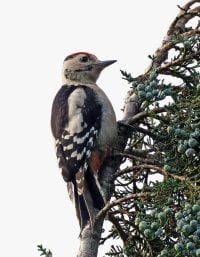
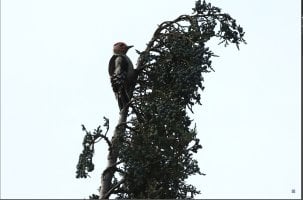
Upvote
0
unfocused
Photos/Photo Book Reviews: www.thecuriouseye.com
Just my two cents. I will defer to more experienced shooters like @AlanF, but to my eyes the examples you are showing look different and worse than the usual focus issues that I’ve experienced with the R7 and that has been discussed in several you tube reviews. Sending in to Canon might be called for.
Upvote
0

